You Need to Offer Callback—Here Are 3 Ways to Get It
It’s no secret that customers dislike waiting on hold. In fact, surveys show that over 60 percent of consumers feel that even one minute of hold time is too much. And businesses dislike it, too—they pay for all time spent on the phone, even when customers are just waiting.
The obvious solution to reduce hold times is to hire more agents. But not only is this rarely a cost-effective solution, it can cause a scheduling dilemma: Having enough agents when call volume is at its peak usually means paying for many agents to sit idle when volume is low.
There is, however, a very outside-the-box solution that consumers and call center managers can both appreciate. It’s called “callback,” or “virtual hold,” technology. We conducted a survey to find out if and when customers appreciate callback, and how they expect businesses to use it. Here, we present those results and discuss three different ways companies can get it.
Nearly Two-Thirds of Customers Prefer Callback
Our first question asked respondents which they’d prefer if they called a company and all agents were busy: waiting on hold, or receiving a call back. The majority—63 percent—preferred callback.
Customer Preferences for Callback vs. Waiting on Hold
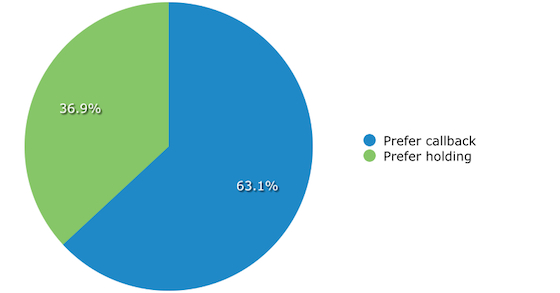
This data suggests that companies that are often forced to make customers wait on hold should consider adding a callback option to their phone system.
Most Customers Don’t Want to Wait Even Five Minutes
Our next survey question sought to quantify the length of time customers would be willing to spend on hold before they would instead prefer a call back. Most respondents said they’d be willing to wait up to five minutes on hold before preferring the callback option. And more than one-quarter indicated they’d always prefer a call back over any amount of time spent on hold.
Time Customers Will Hold Before Preferring Callback
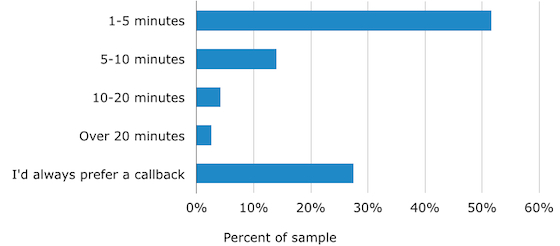
We expected to see a distribution like this: with the number of participants tapering down as the wait time increased. More unexpected was the number of people who do not want to wait even five minutes. This data shows that customers appreciate the callback option even when wait times are short.
Customers Expect a Call Back Within 30 Minutes
It seems clear by now that customers appreciate the option to receive a call back when facing time holding, even when those hold times are five minutes or less. So, after choosing the callback option and hanging up, how long do customers expect to wait for the call itself? A clear majority expect their call to be returned within 30 minutes.
Time Customers Expect to Wait for Return Call
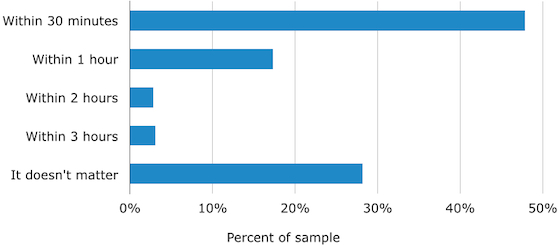
The surprising result here is that over one-quarter of respondents said it does not matter how soon their call is returned. It seems plausible that this is due to the fact that so many people now carry cell phones with them wherever they go, making the timing of the return call less important.
Three Ways to Implement Callback Technology
As sophisticated and adaptable as modern business phone systems are, calls still generally progress in one direction, from caller to callee. From a technology point of view, callback is unique: it coordinates two calls, one in each direction, and usually automates the placing of the second call. It’s not available on all, or even most, business phone systems.
However, companies that decide to add a callback option to their phone systems have a few ways to go about getting it. These include:
As an Integratable Platform
Callback technology has been available since the early 1990s, when it existed in two forms: “valley callback” and “countdown callback.”
Valley callback waited until peak times were over before placing the return call, leaving the customers to wait an unspecified period of time—often hours. Countdown callback placed the return call automatically in the exact amount of time quoted to the customer, whether an agent was free or not. This left agents needing to either ignore the call or else try to juggle two calls at once. Neither method had good results.
It wasn’t until Ohio-based Virtual Hold Technology (VHT) brought the first intelligent callback system to market in the mid-1990s that the technology really took off. VHT coined the term “virtual queuing” to differentiate its solution from the two already on the market. Today its name is synonymous with the technology itself, as many companies and customers refer to callback systems as “virtual hold technology.”
We spoke with Ted Bray, VHT’s vice president of product & field marketing, to learn about how their product is implemented. He explained that VHT’s platform runs on industry-standard hardware which integrates into a standard office phone system (PBX or IP-PBX) or communications switch. The platform also integrates with other software, such as customer relationship management (CRM) programs.
VHT’s callback system offers callers two options. They can enter a virtual queue and receive their callback as soon as they reach the front: VHT calls this its “ASAP” option. Alternatively, callers can choose to schedule a callback at a time they specify, ensuring it will fit into their schedule. This is called the “scheduled” option.
The VHT platform is designed to be a seamless add-on that provides companies with more than just callback. It includes a host of valuable call metrics, showing “before” and “after” changes.
“First, we benchmark where the customer is at in terms of wait times, hold times, abandoned calls, speed to answer etc. And then we track those improvements over time,” says Bray. “The results are very compelling.”
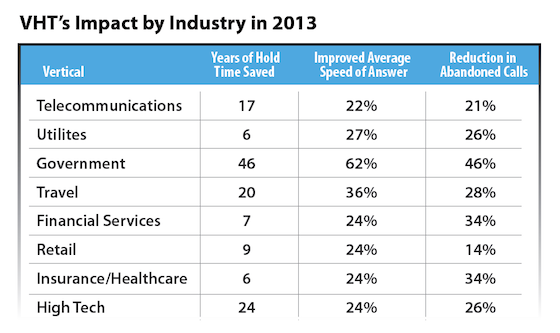
VHT’s technology is very effective across a range of metrics in a wide variety of verticals
Indeed they are. On VHT’s homepage is a counter showing that they’ve saved customers nearly 1,500,000,000 minutes of hold time this year alone.
As a Web or Mobile App
The second means of implementing callback was created by callback service provider FastCustomer. Their idea began when one of its co-founders, Aaron Dragushan, was waiting on hold, getting more frustrated by the minute.
“That seemed to us like an archaic problem,” explains the company’s other co-founder, Mark Quezada. “We thought, ‘two computers should be able to just sit and hold with each other and let me know when someone is on the line.’ And then we just started looking for a way to make that happen.”
And they found one. They started by using Twilio (the telephony integration API for app developers), which, Quezada explains, “got us up and running really quickly. That was a great proof of concept, and only took maybe a few weeks.”
They soon found themselves building their own telephony integration process and refining their calling algorithms, bumping their success rate up from an initial 50 percent to where it stands now—at 95 percent.
FastCustomer’s callback is unique in that it requires a customer to know about the service before they make the call. The process begins when a customer searches for the name of a company on the FastCustomer website or from their Android or iPhone app. The customer then gets to see that company’s current estimated wait time to reach a live agent.
But instead of calling and waiting that amount of time, the customer can click a button choosing to receive a call back. Then FastCustomer dials that company’s number, navigates through the IVR (Interactive Voice Respondent) to reach the correct department, waits until an agent picks up—then calls the customer back and bridges the two calls. The customer doesn’t even need to pick up the phone until there’s an agent ready to talk.
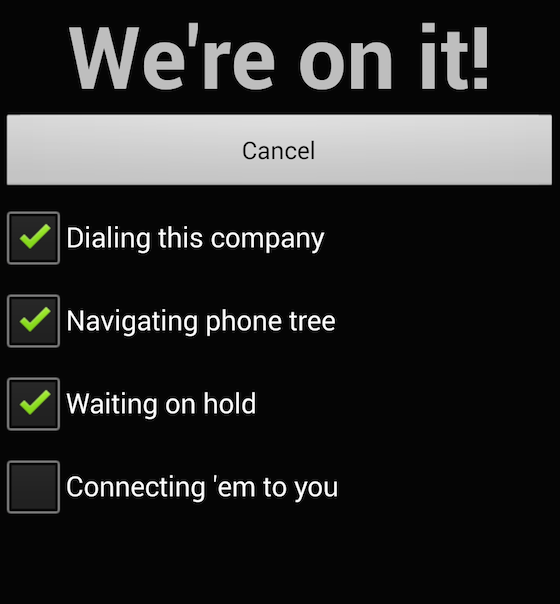
FastCustomer’s Android app checks the boxes as it automatically progresses from step to step
“And from the company’s side,” says Quezada, “it really just looks like the caller is calling in through the [IVR]. There’s really no difference from their side.”
Businesses interested in providing this type of callback can do so by opening an account with FastCustomer. By providing information about their phone systems (e.g., department extensions, IVR choices), the company can then be entered into the FastCustomer database. The company also receives a small widget it can plug into its website. The widget advertises the service and lets customers enter the number at which they wish to receive a callback.
With a New Phone Service
If neither of the above options sound like the right fit, there does exist a third option for implementing callback into a business phone system. It is, quite simply, to start with a new phone system. This is often the best option there is. Five9, 8×8, BrightPattern and ShoreTel are just a handful of many VoIP telephony solutions that offer callback technology.
It’s clear that most customers do prefer callback. And, surprisingly, they prefer it to waiting even just a few minutes on the phone. Given the variety of ways it can be implemented into an existing phone system, or implemented with a new system, it seems a smart way for businesses to improve their telephony platform and save, time, money and their customers’ patience.